What causes back pain in children?
There are several red flag warning signs that may suggest a specific cause for back pain: night pain, constant pain, or pain that spreads into the buttocks or legs are some of them. Leg weakness or bowel and bladder problems (particularly incontinence) are also red flags that can indicate nerve or spinal cord problems.
Conditions that can cause back pain are grouped into nonspecific causes, meaning the cause is unknown, and specific causes/back pain, meaning there is an identified cause for the pain.
With nonspecific back pain there is no specific anatomical structural reason or cause for the back pain that can be found. Approximately 60 to 75 percent of children reporting back pain will have non-specific pain. Their physical exam and X-rays will be normal. It is usually considered a muscle strain or a result of a general strain on the spine from poor posture.
In some cases, non-specific back pain may be related to mood problems such as depression or anxiety. It is even sometimes related to problems at school or with peers.
Specific back pain means a structural cause for the pain is identifiable. Approximately 25 to 40 percent of children will have specific back pain and will show changes on imaging studies (such as X-ray or magnetic resonance images) that indicate a pathological reason (meaning one caused by disease) for their back pain. These causes include the following:
Spondylolysis is a fracture of the pars interarticularis or pedicle(s), usually of the L5 or last lumbar vertebrae. This injury is most likely caused by a traumatic event but it may also be caused by repetitive activity (in this case it is called a stress fracture.)
Spondylolysis is a common cause for back pain in children, especially for those who are intensely active or competitive in sport, particularly at a younger age. The motions that most likely cause spondylolysis include extension (bending backwards) and rotation. Sports that put athletes at higher risk include ballet, gymnastics, football, high jumping, diving, rowing, and weight lifting but other sports can certainly cause this type of fracture as well. Spondylolysis is three times more common in boys than girls. Growth spurts and involvement in contact sports may explain the difference between boys and girls.
In the early stage of the injury an X-ray may not show a fracture. Special imaging tests such as magnetic resonance imaging (MRI), computed tomography scans (CT), or a bone scan may show signs of a stress fracture. Spondylolysis may cause pain in a particular spot in the low back and spasm of the muscles along the spine. Often it will cause pain into the buttocks or thighs. Spondylolysis will often heal with the appropriate rest, a change in activity levels, and by avoiding hyperextension and rotation of the spine. Bracing may be helpful if symptoms do not get better.
Related Document: Next Step Physio's Guide to Spondylolysis
Spondylolisthesis is the slippage of one vertebrae on another. A spondylolisthesis can occur when spondylolysis worsens or does not heal, although a fracture does not always need to have occurred for a spondylolisthesis to be present. A spondylolisthesis can also occur as a result of a malformation of the spine at birth. Despite being present from birth, however, sometimes this slippage is not picked up until later in life when an incident of back pain is being investigated.
A spondylolisthesis slippage is generally graded from I through IV, one being mild, and IV being the most severe, which often causes neurological symptoms.
Related Document: Next Step Physio's Guide to Spondylolisthes
Scoliosis or sideways curvature of the spine may be the source of back pain in some children. Most cases of scoliosis only require monitoring for worsening symptoms, along with physiotherapy to improve muscle strength and flexibility. More severe cases, however, may need bracing or even surgery. In some rare cases a scoliosis is caused by a tumor or infection of the spine.
Related Document: Next Step Physio's Guide to Scoliosis
Scheuermann's kyphosis is a thoracic spine deformity where there is wedging of three or more vertebrae in a row. Wedging means that the vertebra is wider towards the back, and narrower towards the front. The vertebra has lost its usual rectangular shape. This wedging causes increased curvature or forward bending of the spine, which is called kyphosis. The cause of the wedging is unknown. The curve from a sideways view can be 50 degrees or more. If the curvature is greater than 75 degrees, surgery to straighten the spine may be necessary.
Related Document: Next Step Physio's Guide to Scheuermanns Disease
There may also be narrowing of the disc spaces between the vertebrae. Most of the time there are also Schmorl's nodes seen in the vertebral body, which are areas of disc material that bulge into the end plate. On imaging studies these look like small hollowed areas.
Discitis and vertebral osteomyelitis are rare in children. When a disc becomes inflamed and possibly infected, the condition is called discitis. If the vertebral bone becomes infected, the condition is called vertebral osteomyelitis.
Common symptoms of these conditions include refusal to crawl, sit, or walk and complaints of back pain. A limp and forward bending while placing the hands on the thighs for support are also common signs.
With discitis, the disc will appear narrowed on an X-ray or an MRI. Discitis usually occurs in children less than five years old.
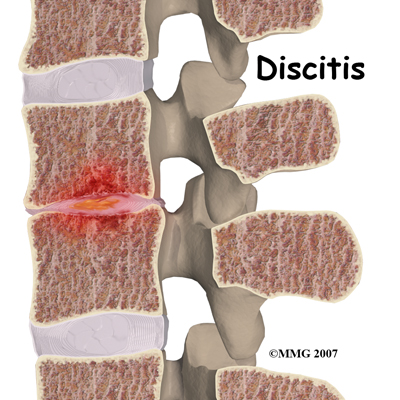
Vertebral osteomyelitis tends to affect older children and adolescents. The vertebral bone and surrounding tissue including the disc can become infected. On X-ray or MRI the bone and/or tissue can show destruction. Fever of 102 degrees Fahrenheit or 39 degrees Celsius or greater is common in vertebral osteomyelitis.
Both discitis and vertebral osteomyelitis are treated with rest, as well as oral and IV antibiotics. A brace to support the spine may be suggested. With osteomyelitis surgery may be necessary to clean out the infection and/or to stabilize the spine.
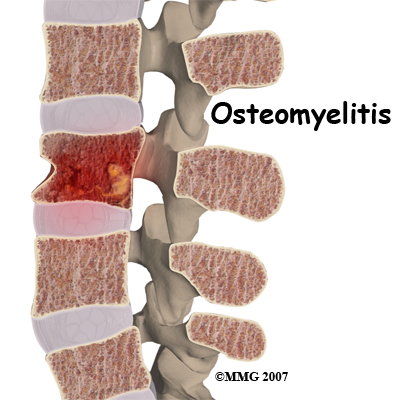
Tumors are another rare cause of back pain in children. A tumor of the spine is an abnormal growth of tissue in or around the spinal column. There are many different types of spinal tumors. They can be benign or malignant. Benign means that the tumor does not spread to other parts of the body. It can still cause destruction of vertebral bone or spinal tissue. Some benign tumors can grow back after they have been removed. Benign tumors include osteoid osteoma, osteoblastoma, and aneurysmal bone cysts. Malignant tumors are tumors that can spread to other parts of the body. These include sarcoma, leukemia, and lymphoma.
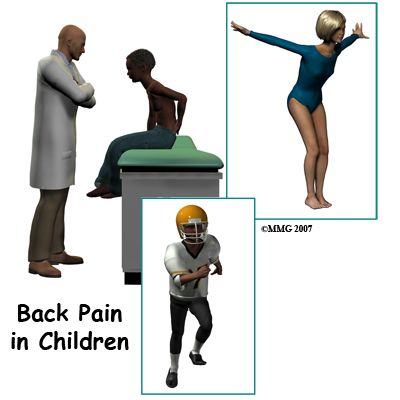


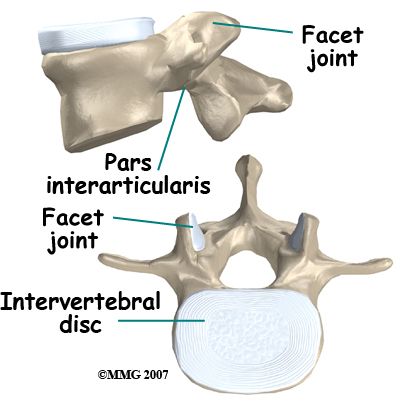 The spine is made up of a column of bones. A round block of bone, called a vertebral body, forms the biggest portion of each segment, or vertebrae. A bony ring attaches to the back of the vertebral body, forming a canal for the spinal cord.
Facet joints are small joints on either side of the spine that allow motion. As the bones of the spine interlock, a facet joint is formed. Each vertebra will form two facet joints, on either side. There is a pair at the top and a pair at the bottom of each vertebra. The area of the vertebra that connects the large body of the vertebra to the facet joints is called the pars articularis or pedicle.
The part between the two sets of facet joints is the lamina.
The spine is made up of a column of bones. A round block of bone, called a vertebral body, forms the biggest portion of each segment, or vertebrae. A bony ring attaches to the back of the vertebral body, forming a canal for the spinal cord.
Facet joints are small joints on either side of the spine that allow motion. As the bones of the spine interlock, a facet joint is formed. Each vertebra will form two facet joints, on either side. There is a pair at the top and a pair at the bottom of each vertebra. The area of the vertebra that connects the large body of the vertebra to the facet joints is called the pars articularis or pedicle.
The part between the two sets of facet joints is the lamina. 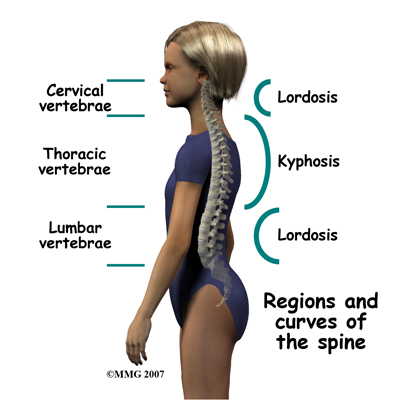


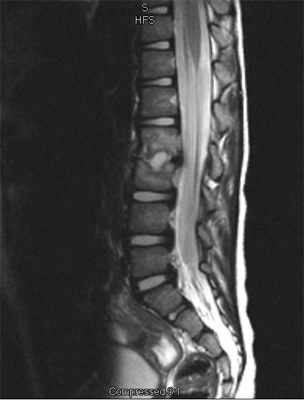
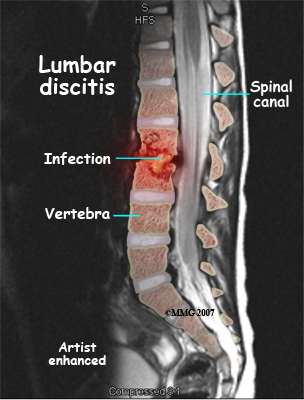
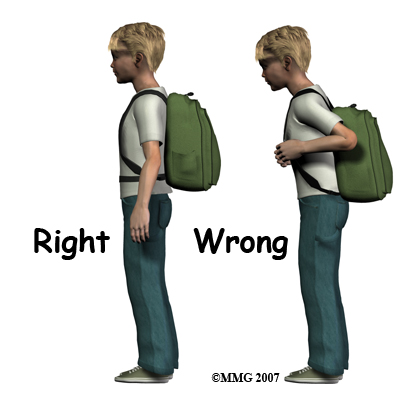 Carrying backpacks may sometimes be to blame for non-specific back pain. Your physiotherapist will discuss this with your child and may ask to see the backpack that your child regularly uses. Many children these days carry extremely heavy backpacks and use backpacks that are poorly designed ergonomically. It is suggested that children wear their backpack using both shoulder straps and that if there is a waist or chest strap, that these straps also be used. When purchasing a backpack, ensure the shoulder straps are wide, padded, and adjustable so that the weight can be evenly distributed. As a general rule backpacks should not be heavier than 10% of your child’s body weight. Making more frequent trips to the locker can decrease the weight of the backpack, and packing the backpack so the weight is distributed evenly can also decrease the strain on the back. Using a wheeled backpack may be an option and should be considered if your child suffers from frequent back pain, or is recovering from an injury.
Carrying backpacks may sometimes be to blame for non-specific back pain. Your physiotherapist will discuss this with your child and may ask to see the backpack that your child regularly uses. Many children these days carry extremely heavy backpacks and use backpacks that are poorly designed ergonomically. It is suggested that children wear their backpack using both shoulder straps and that if there is a waist or chest strap, that these straps also be used. When purchasing a backpack, ensure the shoulder straps are wide, padded, and adjustable so that the weight can be evenly distributed. As a general rule backpacks should not be heavier than 10% of your child’s body weight. Making more frequent trips to the locker can decrease the weight of the backpack, and packing the backpack so the weight is distributed evenly can also decrease the strain on the back. Using a wheeled backpack may be an option and should be considered if your child suffers from frequent back pain, or is recovering from an injury.